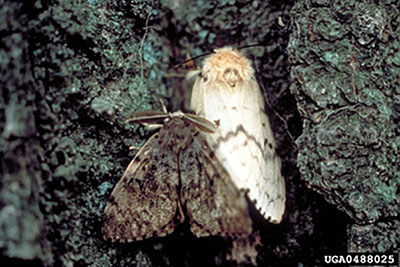My oak tree was defoliated! What can be done?
August 23, 2021
We sometimes hear questions or concerns from several sources at the same time about current conservancy or environmental topics in the Clear Lake Township.
Q: Barb from the West Shore: I noticed large, hairy looking caterpillars (many of them dead) on my Oak trees in July. Now I realize those were caterpillars that have now turned into Gypsy Moths! I know how devastating they can be to our trees and wondered if you have any advice to battle this invasive species?
A.: Bridget: Yes, the European Gypsy Moth is one of the most devastating invasive forest pests in North America. It spread into our area around 1998. We are seeing a lot of European Gypsy Moths this year. Their population size can vary year to year, but infestations can be quite heavy every eight to ten years. This may be one of those years!
This invader can be devastating to our oak trees and are a potential threat not only to homeowners but also to Conservancy preserves such as Brennan Woods where oaks are prevalent.
Let me explain the life cycle of the European Gypsy Moth.

• In April, the caterpillars hatch from the egg mass. They stay near the egg mass until the leaves on the trees start coming out.
• Then, the caterpillars crawl up the trees to eat the leaves. If there are lots of caterpillars, they can defoliate a tree in a matter of days. This is the primary concern! Defoliated oak trees become vulnerable to disease and may not have enough time to grow new leaves.
• As the caterpillars grow, they tend to crawl down the tree to hide from predators during the day.

Photo credit: John H. Ghent, USDA Forest Service, Bugwood.org
• Around Father's Day, they pupate and appear as a bean sized creature with silk threads apparent on them.
• In August, we start seeing the moths emerging. The males are brown, and they fly around frantically trying to find a female to mate with. The females are white with black specks. They cannot fly because they are too heavy with eggs.
• After they mate, the female lays egg masses in areas that are protected. They cover the eggs with hairs to protect them over the winter. They are tan to gold in color and look fuzzy.

Photo credit: Haruta Ovidiu, University of Oradea, Bugwood.org
What we can do
There are some things in nature that are trying to control these moths. There is a virus that is helping to kill the caterpillars. If you saw dead caterpillars on the trunk of your trees, they were likely killed by this virus. That is a good thing! It is recommended to leave the dead caterpillars on the trees as they will keep the virus around the tree, and this will help the tree fight them off next year.
In late summer, you can locate egg masses and scrape them off and put them in soapy water. One egg mass contains eggs for more than 500 caterpillars. You can also use a hose to squirt egg masses higher in trees to disrupt the protective coating, so they don't survive the winter.
If you have trees that were defoliated, the leaves should start regenerating in August. However, this stresses the tree because it cannot save energy the tree uses to survive the winter. Some experts recommend Jobes tree food spikes (three spikes for each inch of trunk) or use a Ross root feeder to get fertilizer to the tree. You can also contact a tree professional or arborist for more detailed instruction. They may want to inject the tree next May with a systemic insecticide that will be absorbed by the tree and will kill the caterpillars when they eat the leaves next year.
If there are a good number of households impacted by the Gypsy Moths, it may be more cost effective to have a certified aerial application in May. They fly 100 feet over the trees and put bacillus thurngiensis (used in organic farming) on the trees. This will kill the caterpillars and should not harm other helpful insects. These aerial applications need to be organized in the fall so that the insecticide can be obtained, and any permits and notices arranged. The cost is about $100-150/acre.
Barb Wenger has offered to collect information about others in the Clear Lake area who have witnessed these caterpillars to assess how serious this problem is. Please email her at barbwenger@gmail.com if you remember seeing these caterpillars or are now seeing the moths or egg masses.
The Conservancy will continue to research this invader and understand the options, if needed, for treatment. We cannot afford to lose the beautiful oak trees in our community. Contact Barb with sightings or the Conservancy with any questions.
